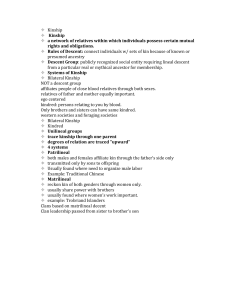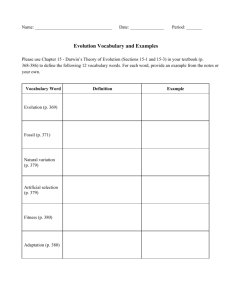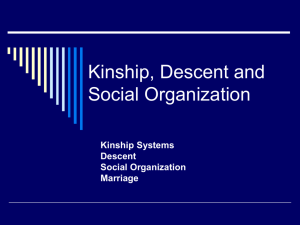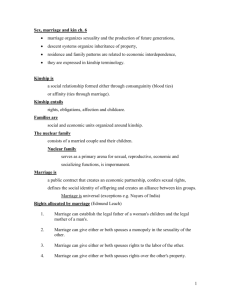Social Organization
advertisement
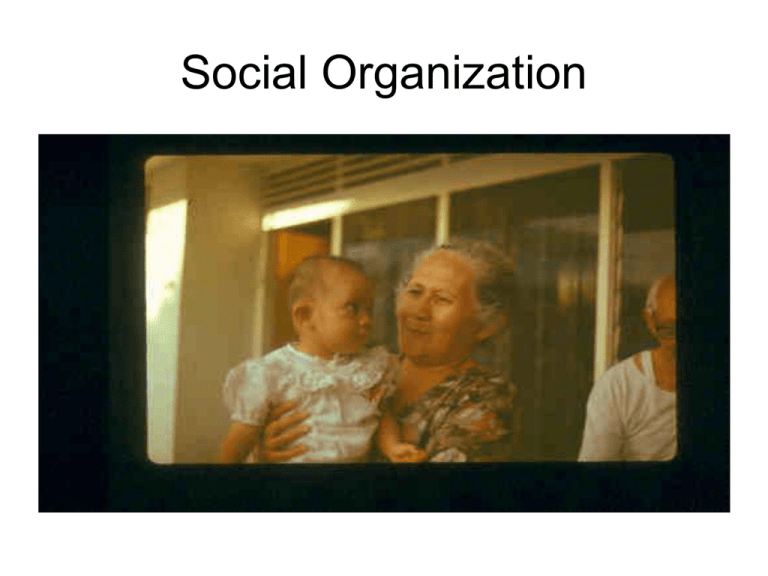
Social Organization Marriage, Family, Kinship • Marriage – rules of sexual access – form of exchange – establishes alliances – accords a child full birth-status rights common to normal members of his society or social stratum. • family -- smallest, organized unit of kin and non-kin who interact daily, providing for the domestic needs of children and ensuring their survival • descent group -- who one is related to beyond marriage • Alliance -- relations between descent groups Forms of Marriage • Monogamy = marriage between two partners • Polygamy = plural marriage = an individual has more than one spouse – Polygyny = one man many wives – Polyandry = one woman many husbands • No marriage • Serial monogamy = preferred practice in the West? Other Forms of Marriage • Same Sex Marriages – A Nuer woman who is unable to have children is sometimes married as a "husband" to another woman who then is impregnated by a secret boyfriend. – The barren woman becomes the socially recognized father and thereby adds members to her father's patrilineal kin group Other Forms of marriage: Ghost Marriage • A Nuer man may marry a woman as a stand-in for his deceased brother – the children that are born of this union will be considered descendents of the dead man -- the "ghost" is the socially recognized father – allows the continuation of the family line and succession to an important social position • A Nuer woman of wealth may marry a deceased man to keep her wealth and power – there will be no living husband, though she may subsequently have children – She is, in effect, a widow who takes care of her husband's wealth and children until they are mature Forms of Marriage • Levirate & sororate – Levirate = a widow marries dead husband’s brother – Sororate = a widower marries dead wife’s sister • Keeps inheritance within the same group Levi-Strauss on Marriage as Exchange • Levi-Strauss: "It's not the man that marries the maid, but field marries field, vineyard marries vineyard, cattle marries cattle” • a set of rights the couple & their families obtain over one another, including rights to the couple's children Marriage and wealth exchange • Bridewealth – payment to wife and/or wife’s family – pays for loss of daughter • Dowry – payment to husband and/or husband family – correlated to low women gender status – pays for adding women to descent group MARRIAGE EXCHANGES • marriage means alliances • people don't just take a spouse they assume obligations to a group of in-laws • often more a relationship between groups than one between individuals-marriage involves are people buying their wives? Or how is a wife like a T.V.? • the price is negotiated & rights are not given to the husband until the deal is done – if the woman proves barren or troublesome the goods are often refunded – women have voice in the transactions – women also has rights of her own in the marriage relationship (commodities don't) • the woman & her kinfolk can also end the marriage if husband does not meet obligations buying & selling of commodities is a one time event • bridewealth establishes an enduring bundle of reciprocal rights & obligations between relatives of the couple that will last as long as the marriage lasts Levi-Strauss and women as objects of exchange • marriage systems - a form of exchange - "that as soon as I am forbidden a woman, she thereby becomes available to another man, and somewhere else a man renounces a woman who thereby becomes available to me." (Levi-Strauss:51) – wife givers & wife takers • nevertheless, as exchange marriage implies reciprocity = obligations assumed in creation & maintenance of alliances Marriage and the Family • Variation in forms of marriage related to variations in forms of family • Nuclear family = parents and children • Extended family = 3 or more generations • Joint family or collateral household = siblings, their spouses and children • Forms of family change over time, over life cycle Forms of Family & Subsistence • Forager band = group of nuclear families • Industrial economy = also nuclear family – Neither foragers nor industrial societies tied to the land – Emphasis on mobility, small-size, self-sufficiency • Cultivators and Horticulturalists = extended, joint, collateral households – Extended family associated with sedentary cultivation, herding & private property – Keeps property in family – Provides needed labor Family in Canada, Europe, US • • • • • A unit bounded biologically & legally Associated with property Economic self sufficiency Associated with emotional life Associated with a space inside a home – Emerges in complex state-governed societies • Keep neighbors out compared to others that add children & neighbors as kin The Modern Euro-North American Family • Family = nurturance, biofunction, love & affection, cooperation, enduring relationships, unconditional • Market = sale of labour, negotiate contractual relations of business, competitive, temporary, contingent relations, law & legal sanctions • family as last refuge against the state (domestic issues & police) • family and litigation today - family becoming contract Post-Marital Residence Patterns • • • • • Patrilocal Matrilocal Bi-local Neolocal Avunculocal – living with mother’s brother or father’s sister • Virilocal – living with husband’s relatives (patrilineal descent) • Uxorilocal – living with wife’s relatives (matrilineal descent) Post-Marital Residence Patterns • 70% of all societies patrilocal • Matrifocal households – women headed households with no permanently resident husband-father • Patrifocal – 3 men and a baby? • Post-marital residence patterns change during life cycle of marriage, over time KINSHIP STUDIES SUFFIXES • • • • Lineal – line of descent Local – place of residence Lateral – of or relating to the side Archy – government KIN TYPES • • • • • Consanguineals Affinals fictive kin Lineals Collaterals DESCENT TERMS • • • • • Bilateral Unilineal Matrilineal Patrilineal Cognatic Endogamous Groups & Marriage Partners Kinship & Descent • For some societies kinship & descent lines are the main way people organize themselves • Kinship societies – The relationships established within the biological group and outside the biological group are coded in kin terms Kinship Patterns • Relations of descent (endogamy) – Consanguineal relationships (sanguine = red) • Relations of blood • Relations of alliance (exogamy) – Affinal relationships (affinity) – Through marriage (in-laws) kinship and descent • kinship as an idiom – a way of expressing social relations and the exchanges, rights, and obligations implied • selective – each system emphasizes different relations • kinship principles define social groups – produces forms of social stratification • locate people within those groups • position people and groups in relation to one another both in space and time kin terms • sometimes mark specific relationships, sometimes lump together several genealogical relations • lineal relatives/consanguines - ancestor, descendent on direct line of descent to or from ego • collateral kin - all other biological kin, siblings, nieces, nephews, aunts, uncles • affines - relatives by marriage Kinship Symbols A circle represents a female A triangle represents a male An equal sign represents a marriage A vertical line represents descent or parentage A horizontal line represents a sibling bond. Relationships are traced through a central individual labelled EGO. kinship diagram UNILINEAL DESCENT (unilateral) • descent group membership figured exclusively through female or male side • matrilineal descent • patrilineal descent Lineal and Collateral Kin Lineal Kin - ancestors or descendants Collateral Kin - sibling branches Matrilineal and Patrilineal Kin • Patrilineal , or agnatic, relatives are identified by tracing descent exclusively through males from a founding male ancestor. • Matrilineal , or uterine, relatives are identified by tracing descent exclusively through females from a founding female ancestor. Patrilineage -- male ego Patrilineage – female ego Matrilateral and Patrilateral Kin Patrilateral Kin Matrilateral Kin cross relatives • kin on each side, who are neither patrilineal or matrilineal • cross cousins are of particular importance, especially for some marriage systems • Cross cousins can be identified as the children of opposite sexed siblings (of a brother and sister) and parallel cousins as the children of same sexed siblings (of two brothers or two sisters). Matrilineal and Patrilineal Kin Patrilineal Kin - linked through males. Matrilineal Kin - linked through females Cross Relatives - cross sexed linked Bilateral Descent • Also called cognatic descent • Canada, US, Europe • ego sees his or her relatives on both sides as being of equal closeness & relevance • the degree of closeness is based on generational distance separating the individuals (our system) Strengths of Bilateral System • • • • Overlapping membership Widely extended, can form broad networks Flexible Useful for groups that do not live in same place • Useful when valued resources are limited Extensions of kin groups • • • • • • • • lineage matrilineage patrilineage segmentary lineage clan phratry moiety kindred Structures of Descent • lineages (patri & matri) - common ancestor • clan – several lineages common ancestor, usually large groups that are associated with mythical ancestors • phratry - unilineal descent group composed of a number of supposedly related clans • moieties - means half, when an entire society is divided into 2 unilineal descent groups • many societies have 2 or more types of descent groups in various combinations • some have lineages & clans, others may have clans & phrateries but no lineages Lineage • a corporate descent group whose members trace their genealogical links to a common ancestor • corporate = shares resources in common – – – – own property organize labour assign status regulate relations with other groups • endures beyond individual members Clan (or sib) • a non-corporate descent group whose members claim descent from a common ancestor without knowing the genealogical inks to that ancestor • often produced through fission of lineage into newer, smaller lineage characteristics of the clan • greater genealogical depth than lineage • lacks residential unity (in contrast to lineage) • a ceremonial unit that meets on special occasions • handle important integrative functions • may regulate marriage outside clan clans are often dependent on symbols as integrative feature • totem: a symbol of a clan’s mythical origin that reinforces clan member’s common descent • totem from Ojibwa ototeman; he is a relative of mine Phratries and Moieties • less common forms of descent groups • phratry: a unilineal descent group composed of at least two clans that supposedly share a common ancestry, whether they do or not • if a society is broken into only two large groups (clan or phratry), each group is referred to as a MOIETY • moieties, phratries, clans and lineages – from most inclusive to the least inclusive – all typically associated with exogamy Bilateral Kindred • a person's bilateral set of relatives who may be called upon for some purpose • no two persons belong exactly to the same kin group • ego centered with kindred of close relatives spreading out on both your mother's and father's sides • connected only because of you
